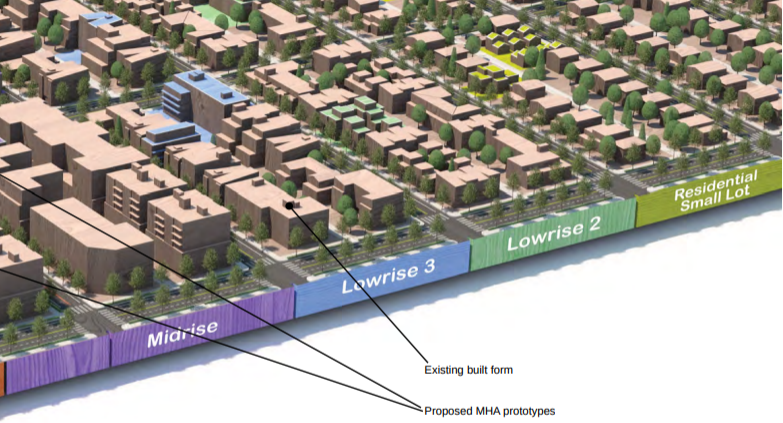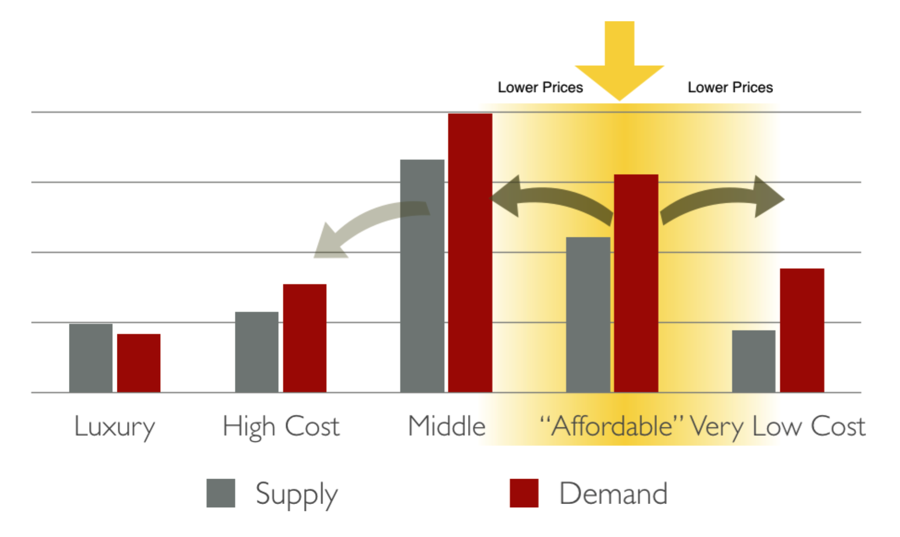Today, the City will hold the final public meeting on “citywide” Mandatory Housing Affordability (MHA) before the Seattle City Council is expected to vote in March and pass the rezone program.
We urge you to attend the MHA hearing at City Hall. It starts at 5:30pm but people hoping to deliver testimony will likely have to show up early. Homeowner groups (organized as Seattle Coalition for Affordability Livability and Equity or SCALE) are rallying the troops to flood the hearing with negative comments. It appears they want to make a last ditch effort to stop or weaken the program after their appeal of the Environmental Impact Statement (EIS), which delayed it by more than a year but failed to invalidate it.
We covered the amendments councilmembers are mulling. Councilmembers Lisa Herbold, Bruce Harrell, Rob Johnson and Mike O’Brien sponsored amendments to scale back rezones near single-family areas in deference to homeowners there. Kshama Sawant, who represents the Council District 3, proposed bigger upzones in some areas and no lessening. Councilmember Sally Bagshaw was conspicuously quiet during deliberations at that meeting.
We urge Councilmember Bagshaw to stand with Councilmembers Debora Juarez, Teresa Mosqueda, M. Lorena González, and Sawant to oppose shrinking the rezones, and increase them where possible. Decreasing the scale of the rezones decreases affordability, shrinking the requirements that are tied to the rezone size.
We ask her and retiring Councilmembers O’Brien, Johnson, and Harrell to reconsider and think about their legacies. Do they want to be remembered for shepherding amendments caving to wealthy homeowners or for standing firm on behalf of struggling folks badly in need of affordable apartments?
Councilmember Herbold is not retiring, but she has proposed the most extensive weakening of rezones of any district for hers. If she is the anti-displacement champion she claims to be, she should abandon her backsliding amendments. Decreasing multifamily housing capacity in West Seattle won’t lower displacement; it will just avoid responsibility to contribute to growth and affordability–and it could end up squandering West Seattle Link investments.
Some lament that the affordability requirements aren’t higher. Some lament that the upzones aren’t larger. What’s clear is that MHA is a step in the right direction and will make our city a better place, harnessing new development–even the most gratuitously luxury development–for affordable housing.

MHA already applies in a handful of neighborhoods in our city. The first was the University District back in February 2017. That upzone is starting to bear fruit with highrises in the pipeline and under construction where formerly they’d been banned and building tons of affordable homes in the process. Despite fears of a slowdown caused by the affordability requirements, development also continues to keep pace in Downtown, South Lake Union, and Uptown where MHA also went into effect in 2017.
The case for inclusionary zoning (MHA in local parlance) in Seattle’s red-hot real estate market is strong. Inclusionary zoning gets housing advocates out of the trap of having to argue for luxury development without having tangible benefits to offer to the average tenant. Rick Jacobus pointed out adding homes in the “affordable” segment helps spread benefits from the middle out, rather than only trickling down from the top. It’s a tangible benefit and a more intuitive argument for advocates to make.

Time and again, urban voters have shown a willingness to trade relaxed density rules or reduced parking requirements in exchange for more affordable housing units.
The same voters who are consistently skeptical of market-rate building for its own sake seem to have no reservation about using market-rate development as a tool to get more affordable housing. The experts have had little success in convincing voters to remove restrictive zoning rules for the sake of more building in general, but there is a proven track record of doing exactly that in exchange for more affordable housing units.
Rick Jacobus
MHA advances the principle of shared responsibility to tackle the affordability crisis. Toward that end, single family zones should not be exempt from MHA rezones and contributions. If you can afford to build or buy a million-dollar home, you can afford to chip in to the affordable housing trust fund via MHA.
Inclusionary zoning also helps prevent landowners from soaking up all the value that upzones create. A new paper by Yonah Freemark found that Chicago neighborhoods that were upzoned saw land value spikes, but not an increase in housing supply within the first five years. This suggests that–while upzones are crucial to meet housing demand at the metropolitan scale–in the short-term on the neighborhood scale, they can have detrimental effects–at least in the absence of inclusionary zoning to dampen land value spikes.
MHA adds zoning capacity in a careful way with affordability requirements to redirect land value spikes for social benefit. Thus, MHA all told will generate an additional 6,000 affordable homes in the next decade without requiring City expenditure. It’s actually kind of brilliant and it’s high time the City got around to enacting it.
Doug Trumm is publisher of The Urbanist. An Urbanist writer since 2015, he dreams of pedestrian streets, bus lanes, and a mass-timber building spree to end our housing crisis. He graduated from the Evans School of Public Policy and Governance at the University of Washington in 2019. He lives in Seattle's Fremont neighborhood and loves to explore the city by foot and by bike.


